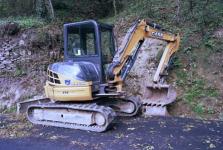|
Kodak Brownie Starluxe II |
Manufactured or assembled in France from (Circa) 1964 to (Circa) 1967.
Index of rarity in France: Very usual (among non-specialized garage sales)
Inventory number: 294
See the complete technical specifications
Chronology of cameras Kodak
At the end of the Second World War, Kodak had two historic factories in France: one in Sevran, which had been dedicated to film development since the 1920s, and another in Vincennes, formerly known as Pathé and since 1927, Kodak-Pathé, where films were manufactured. There were no camera manufacturing units at that time, and all Kodak cameras available in France were imported products.
As part of the national industrial reconstruction effort, imports became much more difficult, and it became necessary to manufacture the cameras sold in France domestically. This is what Kodak did, based on four series of cameras: the 127 series with names starting with "Star," the Pony series, an entry-level 135 series, the Retinette series, a higher-quality 135 series, and folding cameras in the 620 format. For each of these series, Kodak used existing camera models from the USA or Great Britain as a basis. The question arises as to whether this involved true manufacturing or simply assembly with French-made lenses. The Brownie Flash can also be mentioned in this context.
The French Kodak cameras with names starting with "Star" all have a 4 x 4 cm format on 127 film. They are made of plastic, fixed-focus, with a simple eye-level viewfinder integrated into the camera. They have two apertures and a single shutter speed. Loading is done by opening the bottom, which allows access to the two spools and the chamber.
The front face is adorned with an aluminum plate, almost identical from one model to another. The Kodak logo sometimes changes sides, and the Brownie logo evolves. The shutter release lever is very small and red in color. It's possible that some plastic components are common to several models; for example, the Starflash has a parabolic reflector for a bulb flash, but the two holes for flash attachment on the Starlet are clearly visible.
These models are derived from their American counterparts, but across the Atlantic, some "Star" models never had French equivalents.
| Model | Flash | Years | ||
| Starflash |  |
PF1 bulb flash parabolic reflector. The 22.5V battery for the flash is located behind the reflector. | Kodak logo on the left or right. |
1960-62 |
| Startech |  |
Derived from the Starflash, designed for macrophotography. The aperture settings are replaced by those for the focusing distance. | Sold with the essentials for close-up photography. |
c. 1963 |
| Starlet |  |
Side connection for a bulb flash. | Kodak logo on the left or right. Aperture indicated by "Color/ Black & White" or "Hazy Sun / Bright Sun." The plate on the top can be smooth or textured. |
1960-66 |
| Starluxe |  |
Small round reflector for PF1 bulb. In the compartment for the 22.5-volt battery, there is an adapter for AG1 bulb. | 1961-65 | |
| Starluxe II |  |
Small rectangular reflector for a bulb. The technical specifications remain unchanged. | Available in white or two-tone. | 1964-67 |
Traduction de Sylvain Halgand
The only visible technical difference between Starluxe and Starluxe II is the form of the parabola of the flash. On the first model, this one exceeding of the body was to prove too fragile.
Starluxe and Starluxe II are quasi similar to the American models Starmite and Starmite II. However, it should be noted that on the American models, top of the bodies a small metal part exceeds. This piece is absent from models French, whose cap is a little higher (to perhaps mask this piece), with the result that on the local models, the top of the front face ends in a plastic stringcourse. Moreover, on Starmite II, the turn of the lens is black.
Starluxe II exists, at least, in gray-blue and white.
It was worth in 1966 (Natkin catalogs) 49,50 francs , or in outfit 69,50 francs .

Interesting links or bibliography :
Add a link or element of bibliography, a picture taken with this camera, a picture of box or an ads about this camera
Your photos taken with the same camera:
Cameras from Ebay France (Kodak) (Uploaded each 3 hours)








